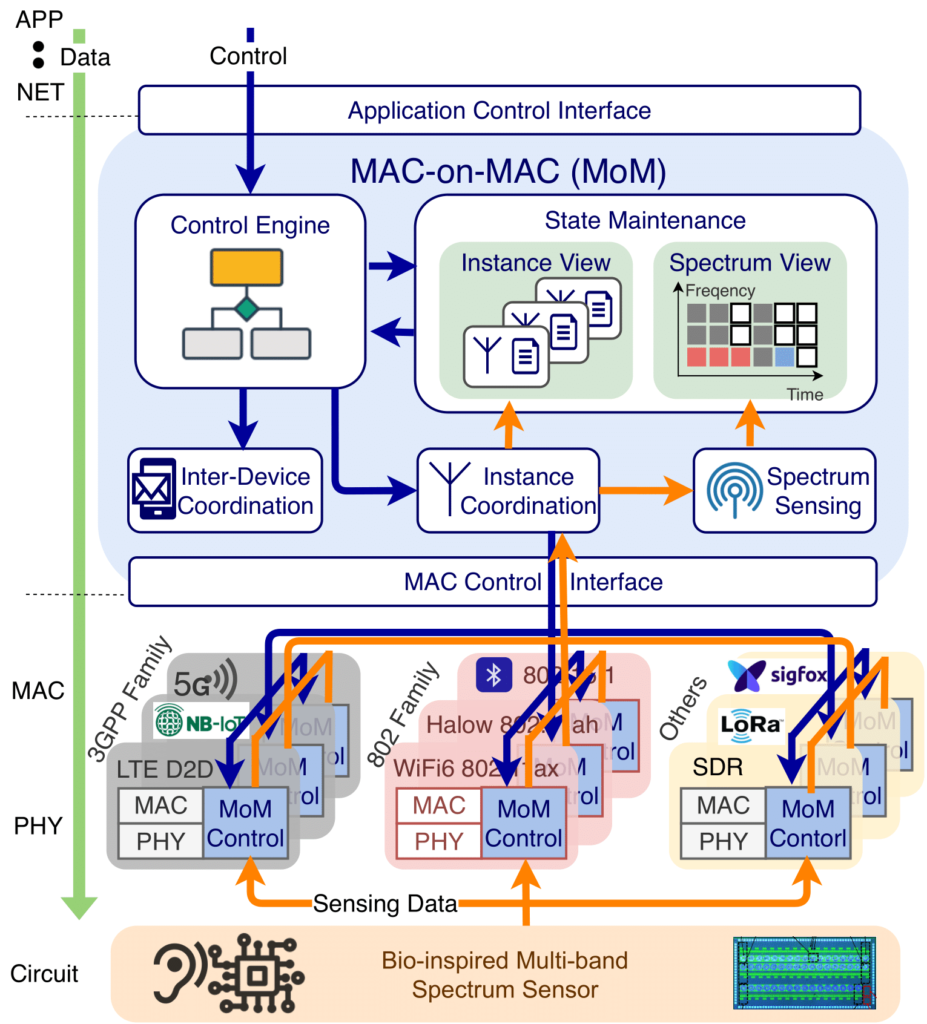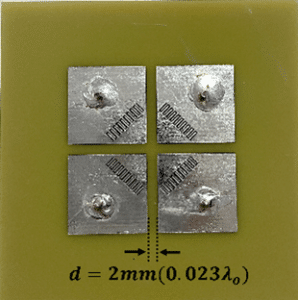MAC-on-MAC: A Spectrum Orchestrating Control Plane for Coexisting Wireless Systems
In this project, we envision that the incoherent and disassociated frequency bands of the multi-RAT coexisting environments can be mitigated by exploiting the potential of cross-layer design from the circuits of transmitter and receiver, to the MAC layer with an innovative MAC-on-MAC spectrum control planen, so as to achieve dramatic improvement in resource utilization and system performance. Our main challenge lies in the demands for new circuit architecture for multi-band spectrum monitoring and cooperative sensing and extreme heterogeneity of devices operating on diverse frequency bands toward a more or less coordination of spectrum access requests. Specifically, we aim to undertake the following tasks: (i) to design innovative transmitter and receiver techniques through cross-layer design for energy-efficient multi-band spectrum monitoring, by using custom single-chip ultra-broadband (1-8 GHz) bio-inspired spectrume sensors to create a multi-band sensing solution that includes both sub-6 GHz and emerging mm-wave bands; (ii) to investigate how to acquire complete spectrum occupancy information with a limited number of measurements from the proposed multiband sectrum sensing circuits by exploiting matrix completion for low-cost, accurate and scalable monitoring through a learning- based sequential scheme; (iii) to study how to obtain a sorted ranking of paths that map a data flow to a range of spectrum slips by modeling spectrum-flow-RAT domains, finding the set of unoccupied spectrum slices, and sorting out multiple recommendations with reinforcement learning techniques, and control messages from neighboring SAP control entities; (iv) to propose MAC-Flow, a flow based network protocol that is capable of handling networking demands from both upper and lower layer, for both traditional user frames and for MoM controller processed frames for system-level performance evaluation.

Principle Investigators

Wenye Wang, Ph.D. Professor,
ECE, NC State University
Phone: 919-513-2549
Email: wwang@ncsu.edu
Website: https://research.ece.ncsu.edu/netwis/

Xin Wang (Stony Brook), Ph.D. Professor,
ECE, Stony Brook University
Phone: 631-632-8402
Email: x.wang@stonybrook.edu
Website: http://www.ece.sunysb.edu/~xwang/

Janise McNair (University of Florida), Ph.D. Professor,
ECE, University of Florida
Phone: 352-392-2629
Email: jymcnair@ufl.edu
Website: https://www.ece.ufl.edu/people/faculty/janise-mcnair/

Yong-Kyu Yoon (University of Florida), Ph.D. Professor,
ECE, University of Florida
Phone:352-392-5985
Email: ykyoon@ece.ufl.edu
Website: https://www.ece.ufl.edu/people/faculty/yong-kyu-yoon/
Students

Rui Zou, Ph.D. student,
ECE NC State University

LoyCurtis Smith, Ph.D. student,
ECE, NC State University

Teng Fei, Ph.D. student,
ECE, NC State University

Pavan Mangipudi, Ph.D. student,
ECE, University of Florida

Payman Pahlavan, Ph.D. student,
ECE, University of Florida
Sharon Boamah, Ph.D. student,
ECE, University of Florida

Hanna Jang, Ph.D. student,
ECE, University of Florida

Xiaomeng Wang, Ph.D. student
ECE, Stony Brook University
Spiha Egan, Ph.D. student
ECE, Stony Brook University

Jinxing Yin, Ph.D. student,
ECE, Stony Brook University

Suk-il Choi, M.S. student
ECE, University of Florida
Recovering Missing Values From Corrupted Historical
Observations: Spectrum prediction is a key enabler of a range of emerging applications, from adaptive spectrum sensing to agile and proactive decision making, for dynamic spectrum access. However, sensing data may be incomplete due to missing readings and anomaly pollution, which makes the spectrum prediction a big challenge. The aim of this work is to accurately and efficiently recover the missing values from corrupted historical spectrum
observations. We first formulate a hankelized time-structured spectrum tensor that can naturally preserve both spectral and temporal dependencies among the historical spectrum observations. We then model the spectrum data recovery problem as tensor completion with its latent low-rank structure and sparse anomaly property. In addition, we also introduce the concept of maximum predictability to reveal the harmful effects of missing data and anomalies, as well as to evaluate the effectiveness of our proposed algorithm from an information theory perspective. Extensive experimental evaluations on the real-world spectrum observation dataset show that the proposed algorithm achieves significantly better spectrum data recovery performance in terms of both recovery accuracy and computation efficiency.
Robust Online Prediction of Spectrum Map with Incomplete and Corrupted
Observations: Spectrum map is an essential tool for a range of emerging applications of 5G and 6G networks. Despite the great efforts on the construction of spectrum maps, access to accurate and valid spectrum
data in a changing environment call for more advanced solutions. In this work, we address the problem of spectrum map prediction when the available historical spectrum observations are incomplete and corrupted by anomalies. We propose three techniques to solve the problem. First, we combine the spectrum map with prediction functionalities for efficient resource management and flexible sharing of resources in dynamically changing environments. Second, by fully exploiting the hidden spatial-temporal- spectral structures of the spectrum data and the sparsity of anomalies and missing data, we model the spectrum map as a 3rd-order spectrum tensor and formulate the spectrum map prediction problem as a low-rank tensor completion problem. Third, we design a robust online spectrum map prediction (ROSMP) algorithm based on the alternating direction minimization method, which derives the tensor decomposition factors for a new timeslot based on the update of existing ones rather than re-computing from the scratch. By gradually learning the hidden spatial-temporal-spectral structures of the spectrum data, ROSMP is able to predict and obtain the complete spectrum map with high accuracy. Finally, extensive numerical evaluations using a real spectrum measurement dataset confirm the efficacy and efficiency of ROSMP and show the superiority of ROSMP over the baselines.
Handovers Employing Software-defined Network (SDN) Enabled Architectures and Multiple co-existing Radio Access Technologies
During the 2021 reporting period, we have worked on developing simulation and test bed environments and training new graduate and undergraduates on the necessary skills to do performance analysis studies. We have completed a survey and taxonomy of the state of the art in academic and industry research related to handovers employing software-defined network (SDN) enabled architectures and multiple co-existing radio access technologies (submitted for publication).
Compact frequency reconfigurable array antenna based on diagonally placed meander-line decouplers and PIN diodes for multi-range wireless communications
A compact frequency reconfigurable 2 ´ 2 array antenna based on diagonally placed meander-line (ML) complementary split-ring resonator (CSRR) decouplers and PIN diodes has been demonstrated. The ML-CSRR structured on the ground plane helps to reduce the mutual coupling between closely located patches (2 mm, 0.015 l0). The PIN diodes which act as switches have been located over the gap between neighboring patches. The antenna operates at 2.4 GHz when PIN diodes are reverse-biased (off-state), while it is reconfigured to operate at 914 MHz when the PIN diodes are changed to forward-biased (on-state). Design is fine-tuned with High Frequency Structure Simulator (HFSS, ANSYS Inc.). The antenna has been fabricated and characterized. The simulated and measured results have been compared. At 2.4 GHz, when the switch is in off-state, the antenna can be used for short-range wireless communications such as Wi-Fi and Bluetooth while at 914 MHz, when the switch is in on-state, it can be planned for the usage of Public Protection and Disaster Relief (PPDR) with the long-range wireless communication technology including low power wide area networks (LPWAN).
Highly Compact and High Gain 2 x 2 Patch Array Antenna with Slotted Meanderline Loading
This paper presents a highly compact and high gain patch array antenna for Citizens Broadband Radio Service (CBRS) applications at 3.5 GHz. The meander line (ML) is etched on each
patch and placed diagonally on top of the patch antenna, resulting in a large current density near the ML slot lines. The proposed antenna design offers advantages through the
characteristic of these current flows: a significant size reduction of a 2 x 2 patch antenna, where the gap between neighboring patches is 2 mm (0.023 of free space wavelength),
the smallest among reported, and a very high gain of 5.67 dB. The inserted meander slot structure, which increases the electrical length of the resonance circuit, contributes to
further reduce the size of each microstrip patch by 51 % in area. The simulation exhibit that the proposed antenna has excellent antenna performance, and thus it is expected to
be useful for multiple compact wireless RF systems.

We strive to make more efforts for collaboration with other institutions. In particular, we have managed following collaborative activities:
- We have organized and kept on schedule of biweekly meetings for the entire group of project, including faculty, undergraduate students and graduate assistants to present the updates in each group. The entire group has been enthusaistic about learning what other groups are doing and are stimulated by requirements and expectations in other topics.
- We have formed three subgroups with respect to detailed and targeted collaboration toward publications. The first group is the antenna design and NOMA implementation, which is focused on dual-band 24 GHz/28 GHz and 3.5 GHz for multiple access (NCSU/UFL); the second group is on spectrum prediction and handoff, which is about how to make the use of spectrum usage and prediction for handoff among multi-RAT (NCSU/UFL); and the third group is about how to design spectrum sening and allocation algorithms (NCSU/StonyBrook).
- We have identified many challenges in consolidating the cross-layer, cross-domain collaboration for the project, and we are making progress gradually, and to some extent, slower than our expectation, though. The PIs will have planning meetings in March and April 2023 to discuss future collaborative proposals to continue their efforts in relevant areas.
Journal Publications
“Downlink Decoding Based Accurate Measurement of LTE Spectrum Tenancy,” Rui Zou and Wenye Wang, in IEEE Transactions on Mobile Computing, 2021.
“Robust Online Prediction of Spectrum Map with Incomplete and Corrupted Observations,” Xi Li, Xin Wang, Tiecheng Song, Jing Hu, to appear in IEEE Transactions on Mobile Computing.
“Recovering Missing Values From Corrupted Historical Observations: Approaching the Limit of Predictability in Spectrum Prediction Tasks,” Li, Xi and Chen, Guojun and Xu, Yinfei and Wang, Xin and Song, Tiecheng (2020) 8. IEEE Access, 8. Published. 2169-3536. https://doi.org/10.1109/ACCESS.2020.3027012.
Conference Publications
“Metamaterial Based Compact Patch Antenna Array for Antenna-in- Package Solutions in Frequency Handover Applications,” P. Pahlavan, S. -I. Choi, A. Wilcher, H. -I. Kim, H. Jang and Y. -K. Yoon, 2023 IEEE 73rd Electronic Components and Technology Conference (ECTC), Orlando, FL, USA, 2023, pp. 475-480, doi: 10.1109/ECTC51909.2023.00085.
“Highly Compact and High Gain 2 x 2 Patch Array Antenna with Slotted Meanderline Loading,” H. Jang, P. Pahlavan and Y. -K. Yoon, 2023 IEEE 73rd Electronic Components and Technology Conference (ECTC), Orlando, FL, USA, 2023, pp. 1917-1920, doi: 10.1109/ECTC51909.2023.00329.
“Compact frequency reconfigurable array antenna based on diagonally placed meander-line decouplers and PIN diodes for multi-range wireless communications,” H. Jang, P. Pahlavan and Y. -K. Yoon, IEEE Electronic Components and Technology Conference (ECTC), San Diego, California, 2022
“Temporal and Spectral Analysis of Spectrum Hole Distributions in an LTE Cell,” Rui Zou, Wenye Wang and Huaiyu Dai, 2021 IEEE Global Communications Conference (GLOBECOM), Madrid, Spain, Dec 2021.
“U-CIMAN: Uncover Spectrum and User Information in LTE Mobile Access Networks,” Rui Zou and Wenye Wang, in Proc. of IEEE INFOCOM, July 2020.
Thesis
“Modeling, Prediction, and Multi-RAT Access of High Resolution Spectrum Based on Decoding Enabled Measurement,” Rui Zou, PhD Dissertation, Computer Engineering, 2023.